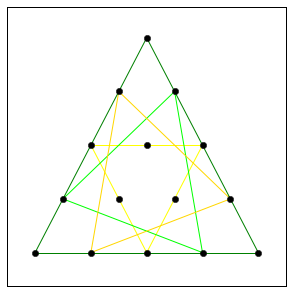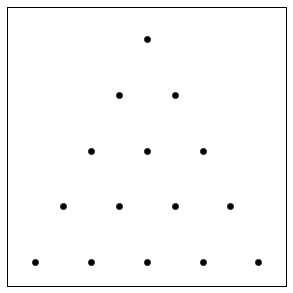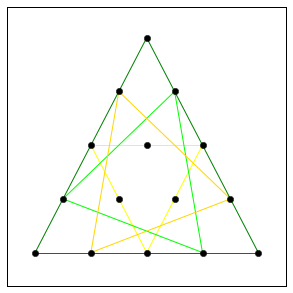"Too Many Triangles?!":General Solution and Thoughts

This note is for the question Too may Triangles?!
Consider an equilateral triangular lattice like the one below :

We'll say that this specific lattice is of size 5 since it has 5 dots on its outer perimeter.
Here we'll think about the question :
On an equilateral triangular lattice of size , by joining dots with straight lines, how many different equilateral triangles can we make?
Part 1 :The Answer and a Solution
Here we'll show that the answer is
We'll define a new equilateral triangle to be an equilateral triangle that can be made on a equilateral triangular lattice of size but not in any smaller equilateral triangular lattice. For example, here are all the new equilateral triangles we can make :

Clearly there exist amount of new equilateral triangle in an equilateral triangular lattice of size for all natural numbers .
So how many unique equilateral triangular lattice of size can we find in an equilateral triangular lattice of size where ?
Well we can find in the row (the bottom row) and in the row and in general we have in the row for , so the total is given by by the sum of consecutive integers formula.
So the total amount of equilateral triangles is given by
the number of new equilateral triangle the number of unique equilateral triangular lattice of size can we find in an equilateral triangular lattice of size which is the same as
Part 2 : Observations and Questions
Let
The total number of Equilateral Triangles we can form on an equilateral triangular lattice of size =
The total number of Equilateral Triangles we can form on an equilateral triangular lattice of size only using lines that are not parallel to the sides of the largest equilateral triangle on the perimeter of the lattice = .
The total number of Equilateral Triangles we can form on an equilateral triangular lattice of size only using lines that are parallel to the sides of the largest equilateral triangle on the perimeter of the lattice .
Note that correspond to the fourth diagonal line of Pascal's Triangle containing the entries of . We can interpret these as the number of points needed to describe a tetrahedron of "size n+1".
Similarly, and corresponds to the fifth diagonal line of Pascal's Triangle containing the entries . We can interpret this row as "The number of points we need to describe a fourth dimensional triangle (aka a pentatope) of "size" n+2 and n+1 respectively" .
It is true that which means that the total number of "non parallel equilateral triangles" in an sized lattice is the same as the total number of equilateral triangles we can make in an sized lattice.
Is there a more intuitive reason why? This also true for the analogue square question.
Note that as the area enclosed by the new n equilateral triangles seems to tend to a Releaux Triangle. In this case

and seems to have similar results for square analogue.
Easy Math Editor
This discussion board is a place to discuss our Daily Challenges and the math and science related to those challenges. Explanations are more than just a solution — they should explain the steps and thinking strategies that you used to obtain the solution. Comments should further the discussion of math and science.
When posting on Brilliant:
*italics*or_italics_**bold**or__bold__paragraph 1
paragraph 2
[example link](https://brilliant.org)> This is a quote# I indented these lines # 4 spaces, and now they show # up as a code block. print "hello world"\(...\)or\[...\]to ensure proper formatting.2 \times 32^{34}a_{i-1}\frac{2}{3}\sqrt{2}\sum_{i=1}^3\sin \theta\boxed{123}Comments
Nicely explained Roberto :)
Awesome! Hats off!!
@Nihar Mahajan , @Azhaghu Roopesh M
Thank you for the kind words :)